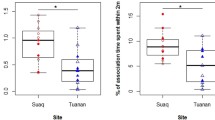Abstract
Studies of several primate species have suggested the existence of a personality dimension typically labeled ‘Sociability,’ which reflects an animal’s tendency to interact with others. The hypothesis that Sociability is related to social skill was tested in the present study by exposing six high- and six low-Sociable adult male rhesus macaques to videotaped presentations of unfamiliar males displaying aggressive or affiliative behaviors. Low-Sociable animals displayed higher frequencies of yawn, lower activity and tended to have higher durations of watching during the presentations that displayed social signals, and significantly fewer lipsmacks to presentations that depicted no social behavior. In response to viewing threats, tooth-grinds, yawns, and lipsmacks, both low- and high-Sociable animals’ most frequent response was to gaze avert; low-Sociable animals, however, had nearly twice the latency to gaze avert than did high-Sociable animals. The low-Sociable animals’ greater tendency to ‘sit and stare’ during the videotaped playbacks suggests that low-Sociable animals have poorer social skills. The possible developmental origins of variation in Sociability, and the functional consequences of such variation for survival and reproduction are discussed.
Similar content being viewed by others
References
Andrews, M.;Rosenblum, L. 1991. Dominance and social competence in differentially reared bonnet macaques. In:Primatology Today,Ehara,A.;Kimura,T.;Takenaka,O.;Iwamoto,M. (eds.), Elsevier, Amsterdam, pp. 347–350.
Baenninger, R. 1997. On yawning and its functions.Psychonomic Bull. Review, 4: 198–207.
Bernstein, I. 1976. Dominance, aggression and reproduction in primate societies.J. Theor. Biol., 60: 459–472.
Caine, N.;Earle, H.;Reite, M. L. 1983. Personality traits of adolescent pig-tailed monkeys (Macaca nemestrina): an analysis of social rank and early separation experience.Amer. J. Primatol., 4: 253–260.
Capitanio, J. P. 1986. Behavioral pathology. In:Comparative Primate Biology, Vol. 2A,Mitchell,G.;Erwin,J. (eds.), Alan R. Liss, New York, pp. 411–454.
Capitanio, J. P. 1999. Personality dimensions in adult male rhesus macaques: prediction of behaviors across time and situation.Amer. J. Primatol., 47: 299–320.
Capitanio, J. P.;Boccia, M. L.;Colaiannia, D. 1985. The influence of rank on affect perception by pigtailed macaques (Macaca nemestrina).Amer. J. Primatol., 8: 53–59.
Capitanio, J. P.;Mendoza, S. P.;Baroncelli, S. 1999. The relationship of personality dimensions in adult male rhesus macaques to progression of simian immunodeficiency virus disease.Brain Behav. Immunol., 13: 138–154.
Capitanio, J. P.;Mendoza, S. P.;Lerche, N. W.;Mason, W. A. 1998. Social stress results in altered glucocorticoid regulation and shorter survival in simian acquired immune deficiency syndrome.Proc. Natl. Acad. Sci. USA, 95: 4714–4719.
Capitanio, J. P.;Reite, M. L. 1984. The roles of early separation experience and prior familiarity on the social relations of pigtail macaques: a descriptive multivariate study.Primates, 25: 475–484.
Chamove, A. S.;Eysenck, H. J.;Harlow, H. F. 1972. Personality in monkeys: factor analyses of rhesus social behaviour.Quart. J. Experiment. Psychol., 24: 496–504.
Dittus, W. 1977. The social regulation of population density and age-sex distribution in the toque monkey.Behaviour, 90: 281–322.
Gosling, S. D.;John, O. P. 1999. Personality dimensions in nonhuman animals: a cross-species review.Cur. Direct. Psychol. Sci., 8: 69–75.
Lindburg, D. G. 1969. Rhesus monkeys: mating season mobility of adult males.Science, 166: 1176–1178.
Maestripieri, D.;Schino, G.;Aureli, F.;Troisi, A. 1992. A modest proposal: displacement activities as an indicator of emotions in primates.Anim. Behav., 44: 967–979.
Mason, W. A. 1970. Early experience and visual information. In:Information Processing and Experiential Deprivation: A Biologic Perspective, National Academy, Washington D.C., pp. 302–323.
Noldus, L. P. J. J. 1991. The observer: a software system for collection and analysis of observational data.Beh. Res. Meth. Instr. Comp., 23: 415–429.
Plimpton, E. H.;Swartz, K. B.;Rosenblum, L. A. 1981. Response of juvenile bonnet macaques to social stimuli presented through color videotapes.Develop. Psychobiol., 14: 109–115.
Schino, G.;Maestripieri, D.;Succhi, S.;Turillazzi, P. G. 1990. Social tension in familiar and unfamiliar pairs of long-tailed macaques.Behaviour, 113: 264–272.
Stevenson-Hinde, J.;Stillwell-Barnes, R.;Zunz, M. 1980. Subjective assessment of rhesus monkeys over four successive years.Primates, 21: 66–82.
Stevenson-Hinde, J.;Zunz, M. 1978. Subjective assessment of individual rhesus monkeys.Primates, 19: 473–482.
Author information
Authors and Affiliations
About this article
Cite this article
Capitanio, J.P. Sociability and responses to video playbacks in adult male rhesus monkeys (Macaca mulatta). Primates 43, 169–177 (2002). https://doi.org/10.1007/BF02629645
Received:
Accepted:
Issue Date:
DOI: https://doi.org/10.1007/BF02629645




